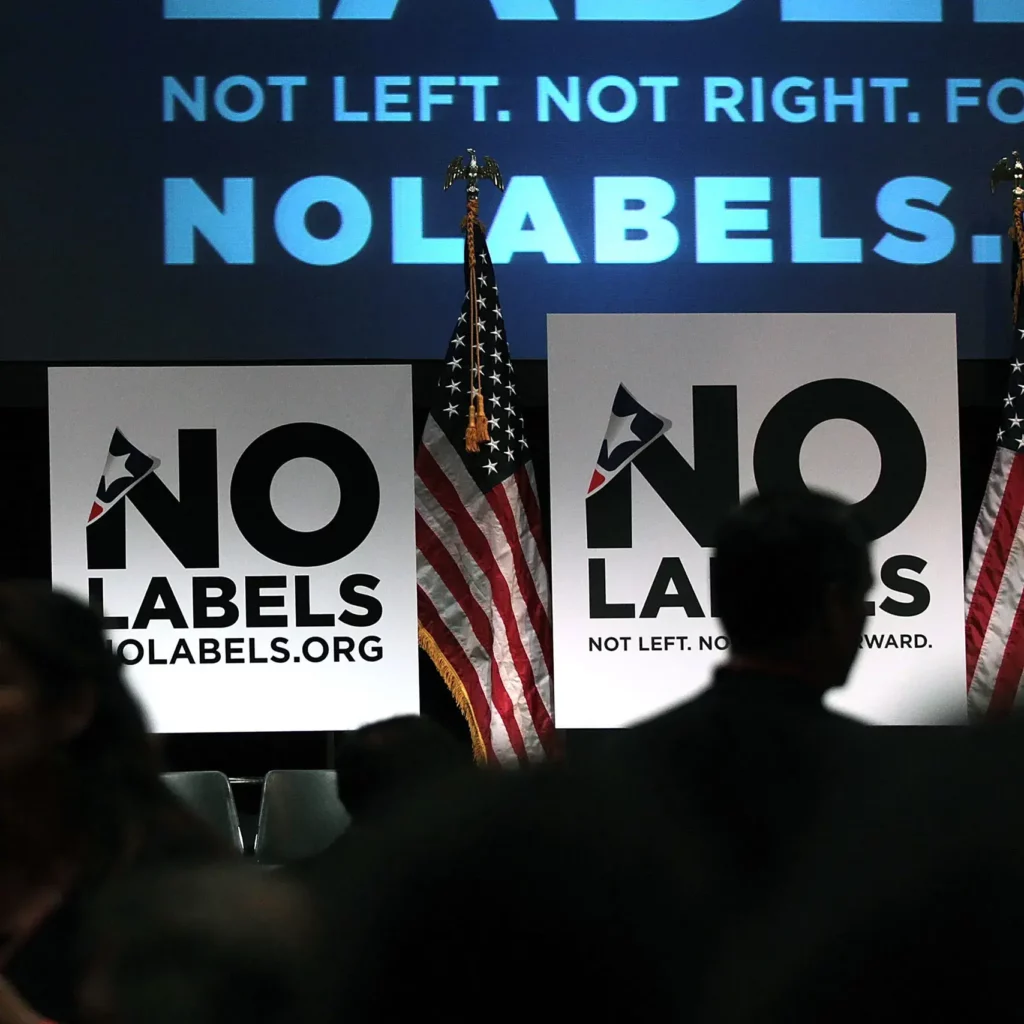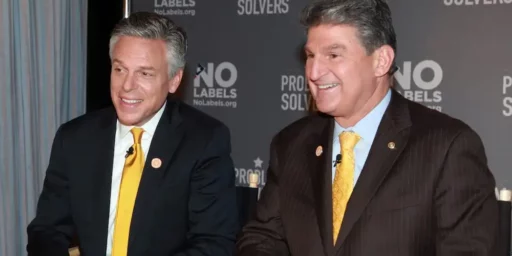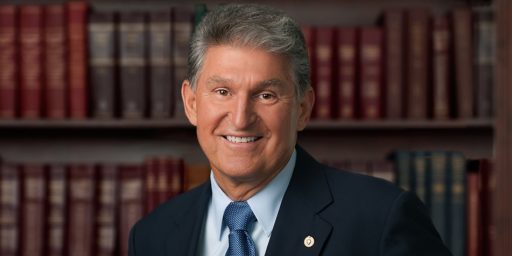Nope Labels
Who could have seen this coming?

Via Dan Balz at WaPo (No Labels wanted a centrist ticket. Polarization, Trump stood in the way.):
For decades now, various politicians have sought to tap into and energize what they see as a moderate middle of the electorate into a viable political movement. For decades, those efforts have come to naught. The latest evidence came a few days ago after No Labels — formed as a bipartisan, centrist organization — gave up its search to field a presidential ticket for 2024.
The quest by No Labels was premised in part on the idea that many Americans are dissatisfied with having to choose between President Biden and former president Donald Trump, the two oldest candidates ever to run for president and, combined, the least popular. In that environment, some thought there was an opening for an independent alternative, and some polls lent credence to the idea.
The effort, however, was doomed almost from the start by perceptions that a No Labels ticket would become a spoiler, with no chance of winning the election and every chance of helping to reelect Trump.
Let me start with the Trump part and then move on to the broader picture (I don’t really address his polarization angle, but largely agree with them–go to his piece to see those). Yes, there were concerns that a No Labels candidate could help Trump. I am not sure I fully even bought that argument, but that is speculation anyway because it is hard to know the answer to that question without even knowing who the candidate was. However, I will confess that I have some sympathy for the position of preferring fewer third-party candidates in this cycle so as to make the choice as stark as possible.
Having said that, the main problem for NL was not Trump (or even polarization), it was the mushy, unclear nature of their goals and the bottom-line fact that there was no one they were going to find to run who was going to have any chance of success.
There simply isn’t this magic route to Centerville wherein a Moderate Centrist is able to draw from the left and right and then win. This is the pundit class’s fantasy about the fiscally conservative and socially liberal candidate who can square the circle and bring balance to the Force.
This is not how it works.
Balz provides the following description of this fantasy:
The concept of a moderate middle of the electorate has long existed. Some politicians have called it a “sensible center” or a “radical middle,” as if it were some kind of sleeping giant within the electorate just waiting to be awakened by the right idea or a charismatic leader.
Two thoughts. First, when I think of he “sensible center” I do not think of charisma. Second, if you movement thinks that the thing it needs to launch itself is a “charismatic leader” then the product must not be all that great.
Inherent in this thinking is the notion that there is a robust middle and that dissatisfaction with the Rs and the Ds as reflected in polling (such as this poll from Gallup from last year: Support for Third U.S. Political Party Up to 63%).*
But Balz rightly notes:
But many who call themselves independent actually lean toward one party or the other and vote loyally as a result — 81 percent, according to a 2019 Pew Research study. As the study said, “Independents often are portrayed as political free agents with the potential to alleviate the nation’s rigid partisan divisions. Yet the reality is that most independents are not all that ‘independent’ politically.”
That same study also underscored the lack of coherence among true independents. Fewer than 10 percent of Americans were labeled as fully independent, according to Pew, and this group “has no partisan leaning.” Beyond that, they were seen as less engaged politically — less likely to be registered to vote and less likely to vote if registered.
That is hardly a broad or stable foundation upon which to build a centrist movement.
Indeed.
I would note that while voters frequently state that they wish they had better choices, their ultimate behavior does not demonstrate that those preferences are especially intense. If Democrats, in the main, truly wanted a different candidate, the primaries would have been a different story. Voter behavior versus stated preferences, is ultimately what matters.
I may sincerely prefer something other than one of the two meals in the refrigerator. But the proof of exactly how much I really don’t want to eat either is my willingness to go to the trouble of cooking something else/being willing to leave the house to obtain a different option.
I may sincerely prefer a third movie to watch, rather than the two you rented from the video store, but if I want to watch a movie and I am unwilling to get in the car to go get another one, I am stuck with what you’ve brought to watch. **
I heard an analyst on NPR this morning state that No Labels wanted a “bipartisan” candidate. This type of analytical framing is a great example of how even someone smart about American politics can be captured by the narratives of American politics. This tracks with No Label’s own language of wanting a “unity candidate”–with the “unity” clearly being between Ds and Rs. The notion that No Labels (or any third party) should be seeking a candidate with “bipartisan appeal” is so captured by the notion that our system is binary that it misses the point that a third party ought to be forming its own partisan identity. It should be a truly new party. Yes, such a party might draw from the voting pools that currently go R or D, but the bottom line remains that as long as third party attempts (and fantasies) are largely conceived of somehow just borrowing parts from the two mainline parties, it just shows how deeply we cannot get beyond the duopoly.
At the most basic level: if we are going to continually talk about a new party in terms of “bipartisanship” then we are demonstrating that we don’t really understand what a true new party should and could mean.
I would note, too, that we only really have this conversation around the presidency in any serious national way. To be honest, this is really not about forming parties, as much as it is providing labels to what amount to various independent candidacies. I will caveat that by noting that the Libertarians, Greens, and a few others do attempt to run at the local level. But that is the extent of serious attempts at third-party formation, and they are pretty anemic in comparison to party systems elsewhere.
Consider the fact the No Labels wasn’t really offering, even at the fantasy level, anything especially new. It was, let’s get a moderate Democrat (Joe Manchin) to run. Or, let’s get a moderate Republican (Larry Hogan) to run. That isn’t creating a new alternative vision for America. It is just hoping that people will vote for leftovers instead of for the main dishes that they claim not to like (but will end up consuming with some level of gusto when the table is set).
While I understand, from a simplistic understanding of the median voter theorem, that many moderate Democrats should, in theory, prefer Manchin to Biden (and certainly to Trump) because of ideological proximity and that if Biden is more liberal that Manchin (he is, but not radically so, I would argue) then if the distribution of voter is more towards the moderate middle than the mildly center-left then a lot of voter should prefer Manchin. Likewise Hogan should appeal to more moderate Reps and even some centrist Dems.
But this overestimates the degree to which voters simply pick the person most closely linked to their precise point on a simplistic ideological spectrum. First and foremost, reality really isn’t a simple spectrum from left to right (and people also have multiple issues that they care about–and therefore we are talking spectra, not a single spectrum). Second, the calculation of who can win comes into play, and being the incumbent president (or a previously sitting president) kind of matters. Third, there is a panoply of other variables, like the fact that Manchin pissed off (that’s the technical term) a lot of Democrats for his behavior in the Senate, Hogan doesn’t exactly have a magnetic personality, and is not widely known, and so forth.
There is also the pesky way we elect the president. For a third-party candidate to win, that candidate would have to be able to not just appeal to the theoretical center of the country as a whole, but to the specific centers of multiple states, each of which has a different left-right distribution than the country as a whole (sometime wildly so).
I would be moderately more sympathetic to these appeals to theories of the median voter if we had a national popular vote with plurality winners or even a run-off system. The mechanics of the Electoral College really cut against viable third-party candidates, despite the fact that the Framers thought that there would be a bunch of candidates and the House would have to choose. But, as I have noted many times, it never worked the way they thought it would (see, for example, How Hamilton saw the Electoral College).
*I, for one, support the notion of a third party. I would like to see more options. But that also does not mean I am going to vote for a third-party candidate in 2024 just for the pleasure of doing so. Ultimately, most voters will behave just as I will, whether they think very deeply about it or not.
**This example brought to you via a wormhole in spacetime from the year 1993. I rejected a similar time warp example of which of the shows that were on TV in 1976 you had to choose from.






In a country clamoring for other options to go against Biden and Trump, we get Stein, West, and RFK, Jr.?
No thanks. I’m voting for the old(er) guy.
@EddieInCA: Don’t forget Marianne Williamson. She was the pick of my friend in Korea who was voting in the Nevada primary (still a US citizen). He’s determined to vote 3rd party in the General. I’ve advised him that if Nevada will be a swing state, he doesn’t have that as an option unless he wants FG elected. I hope he considers my warning.
Lead, follow or get out of the way.
So they got out of the way.
If only the Green Bean Party and assorted other losers would do the same.
You can’t form a party if your ideology is simply that we are above ideology. It’s off-putting in many ways, and that’s probably half the draw for the raising money from billionaires to pay the salaries angle. The other half being giving hacks money for nothing. Looking at their 2021 990, they paid Mark Halperin 240k for this stunt, and are sitting on a balance 9 million of tax-free donations. There’s 1.5 million in advertising expenses. Lmao, they probably gave it to some media consulting bs firm linked to somebody they knew who came back with nifty reports showing ‘metrics’. It’s not like there’s any pressure here for Rational 360 who they paid a million to produce results. There are no real results to produce.
Politics by nature deals with issues, the very things “No Labels” tries to avoid.
Issues are unavoidable and a centrist party must be about compromise to find a “middle ground.” But – some of the most pressing salient issues in present day American politics are poor candidates for compromise, being linked to religion. Dobbs, LGBTQ+, flag and allegiance fetishing, book banning etc. all tie in to Christian Nationalists who aspire to Christian theocracy.
How do you compromise, find middle ground, on abrogating democracy in favor of imposing theocracy? You can’t.
And respect for law? How do you compromise on *tolerating criminality by party leadership, a prominent feature of current American politics? Not easy.
* not really tolerating, often more like encouraging and supporting.
There’s a fair amount of truth to Cleek’s Law. How do we find unity, or even middle ground, between Ds who want X and Rs who want not whatever X is today. Also, too, Biden IS a moderate centrist
I suspect the only way we get a viable national third party is the old fashioned way, a schism in one of the existing major parties. If, gawd forbid, Trump wins, all this becomes moot. If Trump loses, it’ll be interesting to see what happens. I would expect the “establishment” Republicans pto absorb the MAGA, but a split seems possible.
On the contrary, constraining choices determines outcomes. There was no serious primary, as no one of consequence challenged Biden (I’m assuming you’re talking about this year’s “contest”). If the top five or six Democrats had, it would have been a very different dynamic. They didn’t, and that determined voter behavior (primarily reflected by non-participation in the process at all) more than anything else.
And to me, that is fine – parties should, IMO, be able to choose their candidates however they wish, but let’s not pretend the current process is primarily driven by voter behavior or that the outcome of primaries has some special legitimacy because of the veneer of a process that includes voting.
As for No Labels, as politics increasingly becomes binary and tribal, it becomes increasingly difficult to stake any kind of middle ground—by intention. Both sides want to eliminate any space for that. My understanding is that No Labels couldn’t find anyone of consequence who was willing to commit political seppuku by running under their banner for a campaign that would be doomed from the start. Not surprising.
It’s useful to speculate on what kind of platform could support a viable party these days. There’s no logical contradiction in a party that is (say) strongly pro-abortion-rights but also protectionist with regard to resource extraction industries and against immigration of all kinds. Surely there is someone out there doing the math to identify the majority coalitions that are possible, given the fragmentation of what drives peoples’ votes these days.
@EddieInCA:
That’s always the rub. Mr. Imaginary Other Better Option, Jr. can’t run for office. Only us flawed human beings can.
Well, greetings from the “socialist hellhole” Norway! I’m 64 with an “old school” European BA of Political Science, History, and Public Law 1984 (“Davies J-curve, Yay”) and have followed US politics from 1976, when I was firmly in the GOP camp (thanks, Solzhenitsyn), how things change! But the reason I’m writing in, is that the No Labels and Centrism thing generally just seems totally unmoored from any electoral reality and I would like some American perspectives on this.
Here goes: Now, for years the greatest enigma in US politics, to this observer at least, is how so few realize that the whole set of American voters looks very different now than it did before – e.g. in 1980 when I wrote my exam paper on the great Robert A. Dahl’s Political Opposition in Western Democracies. So much of the vaunted centrism in the US is dependent on the voters being spread right to left on a Gaussian or “A”-formed curve, with the “bulk” in the middle, but is this true anymore? I don’t think so, and to me it now looks much, much more like a U-curve between two hills – there is, in other words, no longer a tenable “middle ground” in US politics. It’s just the sub-10 % “real independents” (and they obviously can and do sway tight elections), but the idea that they make up a sizable part of the electorate… Why hasn’t that idea long since been erased by the sheer evidence on the opposite side that there are hardly anyone anymore in the much punter- and commentator-beloved “Middle Ground”? (Fiscally conservative, socially liberal, aren’t they like 295 people in D.C.?) I’d love to read some thoughts pertaining to this on the site (especially since yes, I do believe the “Large Persuadable Independent Middle Voter Chunk” is very much an Inside the beltway hallucination.
I think that was a lot of the folks that think this hypothetical centrist unity candidate will gain traction miss and/or ignore is that the implications of a vote for President is far different that a vote for a Congresscritter.
We don’t have a Parliamentary system, but our Executive Branch political appointments function in a roughly Parliamentary way. In ordinary non-TFG circumstances, whichever party is out of power has something close to a Shadow Cabinet sitting in the wings ready to go. Sure there may be three different folks vying to be picked for Transportation or Interior, but the ideological differences amongst them are vanishingly small.
This is why I will only ever and always vote for the Dem for president even if I split further down. I can afford to cross lines if one of my local mayoral candidates or county commissioner options is on a different team but a substantially higher quality candidate than the one my own is fielding. But I can never afford to allow HHS or Education or Labor to be run by anyone with a “R” after their names.
So unless Joe Manchin or Larry Hogan, Principled Unity Candidate, is willing go public with a confirmed and verified list of folks will to put their necks on the line to say they will serve as the Principled Unity Undersecretary of Commerce before election day even though they are currently in the House as R-Tennessee or D-Michigan, these No Labels type groups utterly forgo the opportunity to be treated with anything even vaguely resembling serious consideration.
Even if by a miracle a No Labels candidate had managed to fluke victory, just how did they ever think s/he could run an effective administration? You would finally have had unity in Congress: both parties would have been determined to ensure the president didn’t get re-elected, by denying them any achievement that might boost their support. They’d be lucky even to get a cabinet approved by the Senate, let alone any “centrist” Supreme Court judges. They’d face obstruction and non co-operation at every turn, cordially loathed by every Trump and Biden supporter.
The idea you could somehow impose “unity” on federal politics from the top down was always idiotic. And in fact it was obvious that the goal of the people behind No Labels was only to bring back the “old” Republican Party in the hope it could fend off Trumpism. When you openly court the runner-up in the Republican Party primary as a “unity” candidate, you’re just insulting people’s intelligence.
The collapse of the No Labels efforts followed the death of Joe Lieberman so quickly that it’s hard not to see the whole exercise as his personal vanity project. He may well have intended to be the candidate himself, “reluctantly” agreeing to run as one last middle finger to the Democrats who were so mean to him and John McCain. I hope the donors who poured millions into the farce feel their money was well spent.
@Ken_L:
This is something that occurred to me that I haven’t seen brought up, possibly because it seems a bit in bad taste. It seems especially plausible given that he died from a sudden accident rather than from illness, where they would have been better prepared.
Of course, even before his death they were experiencing one humiliation after the next as prominent politicians kept turning them down, the latest being Chris Christie. But honestly, I was fairly convinced they’d get someone to go along eventually, just no one high profile.
@ScandiLib:
No, there are millions of people who believe both “my daughter should be able to get an abortion if necessary” and “my taxes are too high”.
You have to remember that the labels are euphemisms, and not descriptive. “Fiscally conservative” doesn’t mean what you think it does; neither does “socially liberal”.